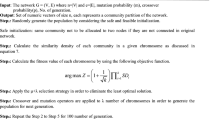Abstract
Genetic algorithms have been used in community detection due to their efficiency and accuracy in automatic discovery of communities in complex networks. The traditional method of population initialization for genetic algorithms does not fully consider topology of a network. Therefore, the quality of the initial population may be poor, which may consequently slow down the convergence of the entire process. According to the characteristics of social networks, we propose a K-path initialization method which makes full use of the topological information of a given network. The main focus of our study is to find whether a K-path initialized generic algorithm can bring significant increase in Q value after the FIRST iteration, and to prove whether such algorithm can accelerate the convergence of the entire process for faster community detection over a randomly initialized genetic algorithm. By applying this new algorithm to Karate, Football, and Jazz, we found that the K-path initialized algorithm can increase the Q value by 50–160% on average over that without using K-path initialization after the first round of iteration. This initial advantage is then accumulated during the subsequent iterations by reducing the number of total iterations by at least 28% and at most 41%.












Similar content being viewed by others
References
Papadopoulos, S., Kompatsiaris, Y., Vakalim, A., Spyridonos, P.: Community detection in social media. Data Min. Knowl. Discov. 24(3), 515–554 (2012)
Chen, Y.L., Chuang, C.H., Chiu, Y.T.: Community detection based on social interactions in a social network. J. Assoc. Inf. Sci. Technol. 65(3), 539–550 (2014)
Chen, Q., Fang, C.: Parallelizing clique and quasi-clique detection over graph data. Technical report. Northwestern Polytechnical University, Xi’an (2014)
Pattillo, J., Veremyev, A., Butenko, S., Boginski, V.: On the maximum quasi-clique problem. Discret. Appl. Math. 161(1), 244–257 (2013)
Girvan, M., Newman, M.E.J.: Community structure in social and biological networks. Proc. Natl. Acad. Sci. USA 99(12), 7821–7826 (2002)
Radicchi, F., Castellano, C., Cecconi, F., Loreto, V., Paris, D.: Defining and identifying communities in networks. Proc. Natl. Acad. Sci. USA 101(9), 2658–2663 (2004)
Clauset, A., Newman, M.E.J., Moore, C.: Finding community structure in very large networks. Phys. Rev. E 70(6), 066111 (2004)
Li, S., Chen, Y., Du, H., Feldman, M.W.: A genetic algorithm with local search strategy for improved detection of community structure. Complexity 15(4), 53–60 (2010)
Shi, C., Yan, Z.Y., Wang, Y., Cai, Y.N., Wu, B.: A genetic algorithm for detecting communities in large-scale complex networks. Adv. Complex Syst. 13(1), 3–17 (2010)
Y. Cai, C. Shi, Y. Dong, Q. Ke and B. Wu.: A novel genetic algorithm for overlapping community detection. In: International conference on advanced data mining and applications, pp. 97–108. Springer, Beijing (2011)
Shang, R., Bai, J., Jiao, L., Jin, C.: Community detection based on modularity and an improved genetic algorithm. Phys A 392(5), 1215–1231 (2013)
Li, J., Song, Y.: Community detection in complex networks using extended compact genetic algorithm. Soft Comput. 17(6), 925–937 (2013)
D. Jin, D. He, D. Liu and C. Baquero.: Genetic algorithm with local search for community mining in complex networks. In: Proceedings of the 22nd international conference on tools with artificial intelligence, pp. 105–112. IEEE Press (2010)
Wang, S., Zou, H., Sun, Q., Zhu, X., Yang, F.: Community detection via improved genetic algorithm in complex network. Inf. Technol. J. 11(3), 384–387 (2012)
Li, Y., Liu, G., Lao, S.Y.: A genetic algorithm for community detection in complex networks. J. Cent. South Univ. 20, 1269–1276 (2013)
Wu, Z., Gao, G., Bu, Z., et al.: SIMPLE: a simplifying-ensembling framework for parallel community detection from large networks. Clust. Comput. 19(1), 211–221 (2016)
Zhang, C., Hei, X., Yang, D., Wang, L.: A memetic particle swarm optimization algorithm for community detection in complex networks. Int. J. Pattern Recognit. Artif. Intelligence 30(02), 1659003 (2016)
Borgatti, S.P., Halgin, D.S.: On network theory. Org. Sci. 22(5), 1168–1181 (2011)
Norris, J.R.: Markov chains. Cambridge University Press, Cambridge (1998)
W.W.Zachary.: An information flow model for conflict and fission in small groups. J. Anthropol. Res. 452-473(1977)
Gleiser, P.M., Danon, L.: Community structure in Jazz. Adv Complex Syst. 6(04), 565–573 (2003)
Lu, H., Halappanavar, M., Kalyanaraman, A.: Parallel heuristics for scalable community detection. Parallel Comput. 47, 19–37 (2015)
Jin, S., Lin, W., Yin, H., et al.: Community structure mining in big data social media networks with mapreduce. Clust. Comput. 18(3), 999–1010 (2015)
Moon, S., Lee, J.G., Kang, M., et al.: Parallel community detection on large graphs with mapreduce and graphchi. Data Knowl. Eng. 104, 17–31 (2015)
Xuan, J., Luo, X., Zhang, G., Lu, J., Xu, Z.: Uncertainty analysis for the keyword system of web events. IEEE Trans. Syst. Man Cybern. 46(6), 829–842 (2016)
Wei, X., Luo, X., Li, Q., Zhang, J., Xu, Z.: Online comment-based hotel quality automatic assessment using improved fuzzy comprehensive evaluation and fuzzy cognitive map. IEEE Trans. Fuzzy Syst. 23(1), 72–84 (2015)
Luo, X., Xu, Z., Yu, J., Chen, X.: Building association link network for semantic link on web resources. IEEE Trans. Autom. Sci. Eng. 8(3), 482–494 (2011)
Acknowledgements
The work is supported by National Natural Science Foundation of China (61272209).
Author information
Authors and Affiliations
Corresponding author
Rights and permissions
About this article
Cite this article
Meng, X., Dong, L., Li, Y. et al. A genetic algorithm using K-path initialization for community detection in complex networks. Cluster Comput 20, 311–320 (2017). https://doi.org/10.1007/s10586-016-0698-y
Received:
Revised:
Accepted:
Published:
Issue Date:
DOI: https://doi.org/10.1007/s10586-016-0698-y




